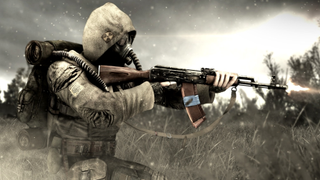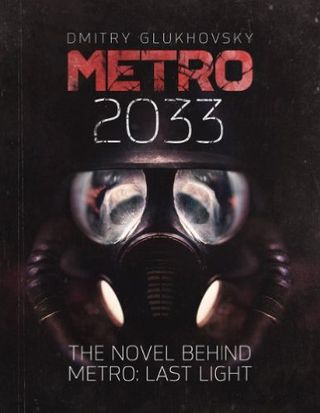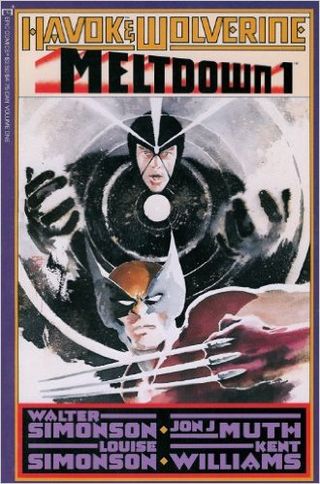If you like STALKER you'll also like...
Films, photography, comics, and novels that speak to the paradigm shift of the Chernobyl moment.

STALKER: Shadow of Chernobyl has atmosphere to burn. Simultaneously liberating and oppressive in its radioactive open world, the series communicates as much horror through its bizarre, mutated landscape as through its scavenging, mercenary gunfighters. But if we’re hunting for the core of STALKER’s unique and enduring appeal, it all boils down to one word—Chernobyl.
The 1986 Soviet nuclear disaster has proven to be the kind of historical moment whose infamy hasn’t faded at all with the passage of time. It’s become the yardstick we use to measure all manner of technological hubris and catastrophe. While I watched the 2011 Fukushima nuclear accident unfold from half-a-world away, Chernobyl was the name that kept flashing through my mind. This is exactly the fear that STALKER taps into—runaway technology that has the power to change something fundamental about the possibility of human survival.
In this way, STALKER’s story of atomic catastrophe exists in a constellation of objects and memories inspired by radiological fear. And some of these, as you’ll see below, in their own way anticipated the disaster that took place in Pripyat. So for this edition of ‘If you like,’ I’ve picked out films, photography, comics and novels that speak to the paradigm shift of the Chernobyl moment as well as its strange and deadly legacy.
Roadside Picnic, by Arkady and Boris Strugatsky

While the 1977 Russian novel exists as the source of the term “Stalker,” it doesn’t address radiological horror directly. Instead it explores the idea of dangerous ‘Zones’ created by an alien visitation. But the novel does deal with the idea of scavenging and the prospect of mutation brought about by spending time in these altered environments.
With the level of detail and thought that the authors put into describing the Stalker experience, it’s no wonder the novel served as the inspiration for the other famous appearance of the term: Andrei Tarkovsky’s 1979 film, Stalker. The film is notoriously slow, even for an art picture, but its story of a human space that’s been made strange and unknowable does anticipate the uncanny threat of nuclear disaster represented by Chernobyl. It’s precisely the reality of how human beings come to understand and live with such an altered landscape that binds both the novel and the film to the STALKER games.
Perhaps in contrast to Tarkovsky’s difficult film, the English language edition of the Strugatsky novel I linked above is highly readable and includes a great introduction by Ursula K. Le Guin.
GAMMA, directed by Factory Fifteen
A short film created by the Factory Fifteen animation and architecture studio, GAMMA sets out to tell a story of renewal in the face of ecological destruction. In a post-nuclear world, a new kind of fungus technology is developed to reclaim regions devastated by radiological contamination, including areas in the former Soviet Union. But things don’t go quite according to plan.
The biggest gaming news, reviews and hardware deals
Keep up to date with the most important stories and the best deals, as picked by the PC Gamer team.
The film packs an emotional punch through its documentary-style voiceover and clever mashup of real environments and special effects.
Metro 2033, by Dmitry Glukhovsky

Many of you will likely be familiar with Metro 2033 and its sequel Last Light, the games I feel echo most closely the feel of STALKER. Based on Dmitry Glukhovsky’s series of novels, the Metro games are worth bringing up in any discussion of the STALKER series because in certain ways they surpass it. Set in the Moscow metro system in the years following a nuclear apocalypse, Metro puts radiation at the very center of its story.
The way Metro deals with issues of scarcity and breathable air through the use of gas masks has always struck me as one of the most terrifying challenges in any game. Will I be able to breathe? Will I find the ammunition I need to make it through this passage? Again, if we are to look at the STALKER experience as one bright point in a constellation of artifacts responding to the Chernobyl moment, the Metro novels and games are for me the most recent and effective iteration of this fear.
The Long Shadow of Chernobyl, Gerd Ludwig photographer
One of the leading photographers working to document the aftermath of the Chernobyl disaster, his work doesn’t make for easy viewing. But the reality that his camera records has always felt like a significant part of what makes STALKER’s atmosphere so captivating. Through their mixture of recognizable ruins and mutated bodies, the games hint at the idea that somehow, maybe, we could create a place of similar terror in our own world. And I think Ludwig’s photography captures images that actually approach that horrific possibility—the terrible effect of radiation on both the body and the mind.
The video embedded below is a short preview of his major project on this topic, The Long Shadow of Chernobyl, which is also available as an interactive app for the iPad.
Meltdown, written by Louise Simonson and Walter Simonson, drawn by Sherilyn Van Valkenburgh, Jon Jay Muth, Kent Williams, Ballard Borich

Havok has always felt like the comics character who most closely represents the power and unstable reality of our nuclear age. A conduit for the storage and processing of both cosmic and man-made radiation, Havok is the ultimate Cold War mutant. And in Meltdown, a four-issue miniseries first published in 1988, we see how Havok and Wolverine respond to the dangers of a post-Chernobyl planet. Even if their story of international adventure and atomic espionage becomes a bit tough to follow at times, for me the most direct connection to radiological fear can be seen in Van Valkenburgh’s artwork.
Drawn in a high-contrast, watercolor style, it perfectly captures the surreal power and deep pessimism of our nuclear age.
